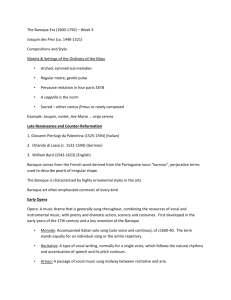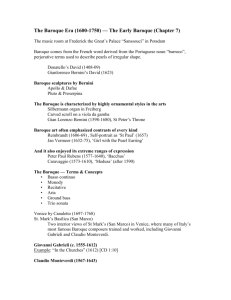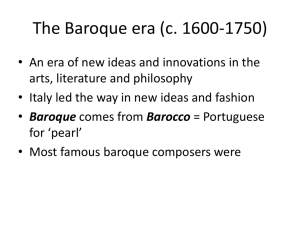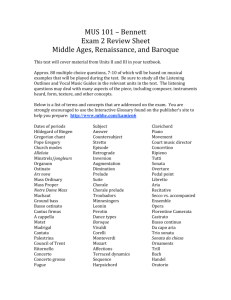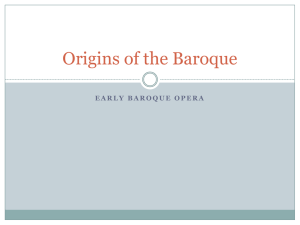Beethoven's Works
advertisement
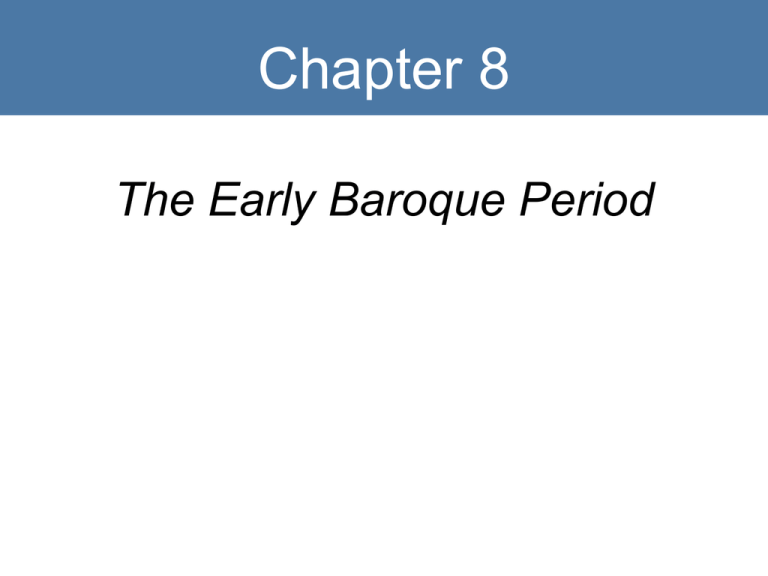
Chapter 8 The Early Baroque Period Key Terms • Basso continuo • • Ground bass (basso • ostinato) • • Functional harmony • • Opera • • Recitative • • Aria Suites Fugue Variations Toccata Canzona Passacaglia Renaissance and Early Baroque Timeline Early Baroque (cont.) Renaissance to Baroque • A period of rapid change • New emphases – Expression of strong emotion – Solo singing • New styles – Recitative; theatrical style – Instrumental and dance music Renaissance vs. Baroque Renaissance • Human voices superior • Vocal ensembles • A cappella ideal • Natural, simple musical ideas • Irregular, floating rhythms • Modal harmony • Church and chamber • Declamation and word painting Baroque • Instruments equally important • Solo singers • Voice with accompaniment • Artifice and virtuosity • Clear, dance-like rhythms • Functional harmony • Theater, church, and chamber • Expression of strong emotions Venice • Major center of tourism and trade • “Most Serene Republic” • Typified magnificence and extravagance – In art and architecture – In music St. Mark’s Basilica • The center for Venetian music • Extravagant architecture – Many Byzantine mosaics – Many balconies; two choir lofts • Extravagant music – Using two or more choirs in alternation – Mixing of voices and instruments Extravagance and Control • New freedom of expression • Break from tradition • Rigorous and systematic control of new forms • Expressive yet organized music Giovanni Gabrieli (c. 1555–1612) • Prolific composer and organist at St. Mark’s • Mixes delicate, expressive passages and rich, brilliant echo effects Gabrieli, “O magnum mysterium” Renaissance features • Uses vocal ensembles • New melody for each phrase of text • Careful declamation and text painting “O magnum mysterium” Baroque features • Equal treatment of voices and instruments • Clear, often dance-like rhythms • Clarity: parallels between beginning and end • Intensification – Repetition and sequence – Theatrical contrasts • Interplay between choirs and instruments “O magnum mysterium” “O magnum mysterium” O magnum mysterium et admirabile sacramentum ut animalia viderunt Dominum natum iacentem in presepio: Alleluia, alleluia. O great mystery and wonderful sacrament— that animals see the Lord new born lying in the manger: Hallelujah, hallelujah. Style Features of Early Baroque Music • Emotional expression tempered by control • Methodical use of musical elements to express emotions – Rhythm and meter – Basso continuo – Ground bass – Functional harmony Rhythm and Meter • Strong beat and regular meter • Consistent repetition of patterns • Different patterns for different emotions • Range between two extremes – Recitative – Dance music Texture: Basso Continuo • Consistent feature of Baroque music – Strong, reinforced bass line – Strong harmonic foundation • Played by – Bass melody instruments (cello, bass) – Chording instruments (keyboard, lute) Texture: Ground Bass • Ground bass = Basso ostinato, repeating bass line • Ostinato is a nearly universal practice Functional Harmony • Relies on major and minor scales – Sense of stability – Disorientation of dissonance or modulation • More focus on chord progressions over strong bass line • More predictable, purposeful—more modern! Opera • Most characteristic Baroque art form • Ideal vehicle for individual emotionalism • Ideal example of extravagance and control – Lavish mix of many art forms – Rigid schemes (recitative and aria) Recitative vs. Aria Recitative • Free, speechlike rhythms • Pitches follow speech patterns • Continuo accompaniment • Prose text (words stated once) • Advances the action (movement) • Dialogue (free interaction) Aria • Clear beat, consistent meter • Pitches form melodic patterns and phrases • Orchestral accompaniment • Poetic text (phrases often repeated) • Freezes the action (reflection) • Soliloquy (expresses one emotion) Claudio Monteverdi (1567–1643) • Leading figure in music c. 1600 • “The last great madrigalist and the first great opera composer” • Mantua court (1589–1612) – Orfeo, opera’s first masterpiece • St. Mark’s, Venice (1612–1643) – The Coronation of Poppea Monteverdi, The Coronation of Poppea • Poppea is mistress to Emperor Nero • Their love triumphs after – Poppea’s former lover is banished – The Empress is set to sea – Nero’s adviser is forced to commit suicide • Poppea is crowned Empress of Rome The Coronation of Poppea Act I: • Nero’s guards grumble outside Poppea’s house • Poppea’s former lover shows up • Poppea and Nero sing a lingering farewell (recitative) • Poppea sings of her hopes and her ambition to become empress (aria) The Coronation of Poppea From Act I, Recitative • Rhythm dictated by words and dialogue – Speeds up and slows down freely • Short arioso (songlike) passages – Support Nero’s flattery of Poppea The Coronation of Poppea From Act I, Aria • A kind of victory dance in three sections • Recitative indicates moment of uncertainty • Energetic rhythms depict section 3’s battle Henry Purcell (1659–1695) • Greatest English Baroque composer • Member of Chapel Royal and organist at Westminster Abbey • Sacred, instrumental, and theater music • Influenced by French and Italian music • Wrote the first real English opera, Dido and Aeneas Purcell, Dido and Aeneas • Story from Virgil’s epic poem, The Aeneid • After escaping from Troy, Aeneas falls in love with Queen Dido of Carthage • Malicious witches make Aeneas believe that Jove has ordered him to continue his journey • Furious at his rejection, Dido spurns him • Dido commits suicide in the final scene Dido and Aeneas Act III, final scene • Recitative – Dark, somber tone – Mostly minor mode with chromaticism • Aria – Descending bass line – Repeated phrases • Chorus – Alternates imitation and homophony – Uses word painting Dido and Aeneas Act III, final scene, Aria The Rise of Instrumental Music • Vocal music was Renaissance ideal • New instrumental genres emerged in Baroque era • Three main sources – Dance – Virtuosity – Vocal music Dance • Opera firmly linked to ballet • Dance suites for orchestra • Stylized dances and suites for harpsichord • Dance rhythms in all genres Virtuosity • Instrumental music was now written down • Virtuoso performers used written music as a guide for improvisation Vocal Music • Baroque favored solo singers • Imitative polyphony moved to instruments – Development of fugue – Sets of variations on vocal tunes Girolamo Frescobaldi (1583–1643) • Leading organ virtuoso • Famous performer, composer, and teacher • Worked in Florence and Rome • Known for expressiveness and extravagance Instrumental Genres • Toccatas – Free-form works; capture spirit of improvisation • Canzonas – Rigorously organized; emphasize imitative textures • Stylized dances – Short, binary form, often in suites • Sets of variations – Based on vocal melodies or harmonic patterns Frescobaldi, Suite, Canzona • First section uses single motive imitatively • Contrasting section introduces new motive for imitation • Tend to end with strong cadences Frescobaldi, Suite, Balletto and Corrente • Common pairing of slower and faster dances • Inner vs. outer form – Both binary form, homophonic, same key, similar bass lines – Balletto: duple meter, slow tempo – Corrente: triple meter, faster tempo Passacaglia • A set of variations on a brief series of chords and their bass line • Similar to ground bass works, but bass line repeated less strictly Frescobaldi, Suite, Passacaglia • 18 variations of a simple pattern – Four-measure harmonic pattern – Inconclusive ending on dominant • Frescobaldi creates endless variety – Inverts or omits the ground bass – Changes rhythms and chromaticism – Switches last five variations to minor mode
